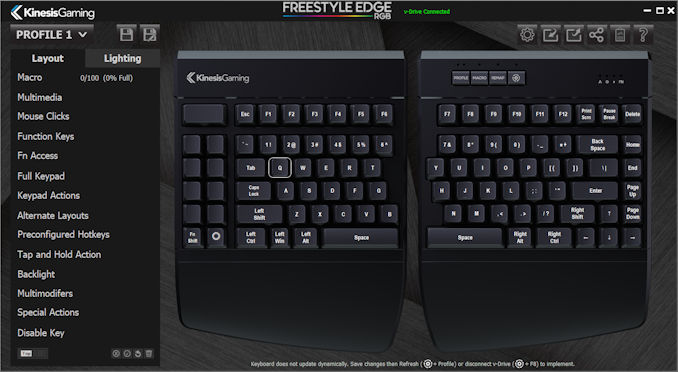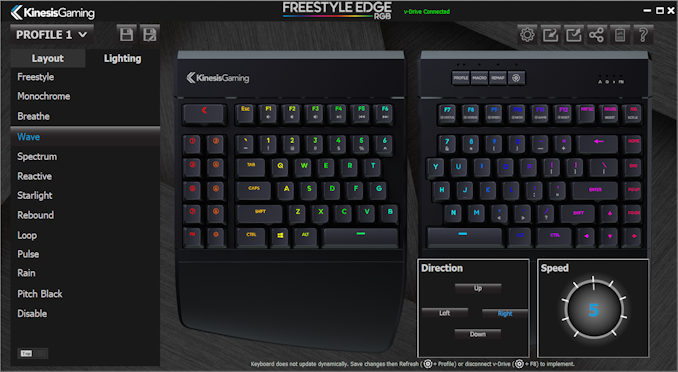The Kinesis Freestyle Edge RGB Gaming Mechanical Keyboard Review: An Ergonomic Masterpiece
by E. Fylladitakis on July 16, 2019 1:30 PM ESTThe KinesisGaming SmartSet App
As with any really advanced keyboard, one of the primary features of the Freestyle Edge RGB is its software. Kinesis named their software SmartSet. What is truly unique about the software is that it is a completely portable application – no installation necessary – and that it lives on the keyboard itself, via the keyboard's integrated "vDrive" USB flash drive. After enabling vDrive (Fn + F8), the SmartSet application becomes available, and it in turn stores everything back in to the keyboard’s internal memory. In short, it is nothing but a tool that assists the users with programming their keyboards.
Every change that is saved while using the SmartSet app is permanent, meaning that the keyboard will retain all of its programmed profiles, commands, lighting effects, macros, and everything else, regardless of the device is it plugged in. Once it is programmed, it requires no software to perform any of the programmed functions and even the host device’s OS is mostly irrelevant, save for any programmed OS-specific commands (if present).
The flip side of this portability, however, is that it limits the advanced programming capabilities of the software. Simple actions, such as multimedia functions, special characters, and even mouse clicks can be tethered to any key. But advanced commands, such as launching third-party applications, are not supported. That is because no external device can actually “tell” the OS what to launch. An installed application can do so, which is why most of the competition supports this function, but that is not something one can implement on a device that requires no software at all.
Kinesis has significantly refined the SmartSet application since last year. It now is a two-page configuration screen, split between layout and lighting programming. The interface is cleaner and there are more configuration options. There are also buttons that can initiate a tutorial, updates, profile import and export commands, and global configuration changes.
Users can reprogram any key, both on the “top” and the “Fn” layers of each profile. The keyboard supports nine profiles and, with two layers each, that is quite a lot of possible layout variations. Aside from simple layout changes, users can also tether advanced functions, keystrokes, or even complete macros to every single key. Advanced functions may be limited by what the keyboard can actually do without having to use any installed software but Kinesis does offer a hoard of options, ranging from multimedia controls to multi-modifiers. Mouse clicks also are available, but mouse movements commands are not.
Kinesis also has semi-automated layout changes implemented into the software. These options allow the user to program a full keypad on either side of the keyboard, or even change the entire keyboard’s layout entirely (such as to Dvorak, Colemak, or Workman). This makes it possible to switch the keyboard’s layout without affecting the OS’s native setup.
The Macro recorder is relatively basic. The initial version of the recorder was limited to simple keystroke combinations but Kinesis evolved it a bit and it now supports delay programming. There is also a repeat option but is limited to nine iterations. The playback speed of the macros can be either individually adjusted or set to follow the “global” setting.
One of the unique aspects of the macro programmer is that the user can select a “trigger” key per particular macro. The trigger key is one of the Shift, Alt, or Ctrl keys. Launching the macro requires the trigger key to be pressed prior to pressing the key that the macro is tethered to. This way, it is possible to store up to three different macros into any single key, as long as they use a different trigger.
The second page of the software allows for lighting programming. It is relatively simple to program the lighting effects per profile, with several pre-programmed visual effects already present. If a pre-programmed effect is selected, the user can adjust its direction and speed. Per-key manual programming is also possible.
At this point, we must emphasize that one must not forget to click on the “save” button after making any changes. Everything, from layout changes to lighting effects, is stored in the keyboard’s internal vDrive memory. If the software is closed without saving the changes or if the keyboard is disconnected from the system, any and all changes will be lost.















51 Comments
View All Comments
halikarnas - Tuesday, July 16, 2019 - link
Why are titles of Anand articles hyperlinks ? And it redirects to the articles themselves. I like to select the text that I read and I almost always click the titles by mistake while doing it and the page refreshes. It's not convenient.GreenReaper - Tuesday, July 16, 2019 - link
So that you can copy the link and/or go back to the start page in one click, I guess?halikarnas - Tuesday, July 16, 2019 - link
When you click the title of an article the page refreshes, it does't go to the start page. It's simply useless to me, or there is something that I don't understand.Calista - Tuesday, July 16, 2019 - link
Well, it does bring you to the first page of the article. But yes, I agree. I would much rather have it be plain text.Ryan Smith - Tuesday, July 16, 2019 - link
This was the idea behind it, yes.vanilla_gorilla - Tuesday, July 16, 2019 - link
I thought I was the only one. This bugs me, too.waja - Tuesday, July 23, 2019 - link
I'am really happy to know that george earn 3450$ every month at home just working few hours on internet if you interested to join this work so welcome now and copy this link................. www.online-3.comEJ42 - Tuesday, July 16, 2019 - link
This keyboard might not suck if they didn't have the stupid design that connects both halves. Each half should have its own USB port that can be independently run to the computer. The right-half could just have a USB hub on it to let you connect it the way they designed, but allow you to disconnect and run any length of cable you want directly to the PC without having them tethered together.This way, a gamer could just leave the right half completely out of the way without having to find some awkward place to shove it to while gaming.
snowmyr - Tuesday, July 16, 2019 - link
Yeah. I can't stand any keyboard that doesn't let me get rid of the right half of it when gaming. God they suck.Midwayman - Thursday, July 18, 2019 - link
Where are you going to put your beer, right?